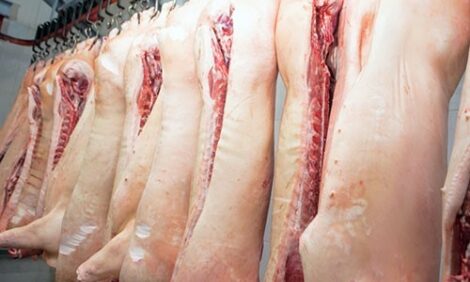



Chinese Pig, Human E. coli Only Distantly Related
CHINA - Extraintestinal pathogenic E.coli (ExPEC) that occur in pigs showed different virulence gene patterns for different clonal complexes but the majority of these fell into different groups from human ExPECs, according to new research from Wuhan.Extraintestinal pathogenic Escherichia coli (ExPEC) can cause a variety of infections outside the gastrointestinal tract in humans and animals, according to a new paper published in BMC Veterinary Research. Yi Ding of Huazhong Agricultural University in Wuhan and co-authors there and at the China Animal Health and Epidemiology Center in Qingdao report that infections due to swine ExPECs have been occurring with increasing frequency in China. These ExPECs may now be considered a new food-borne pathogen that causes cross-infections between humans and pigs. Knowledge of the clonal structure and virulence genes is needed as a framework to improve the understanding of phylogenetic traits of porcine ExPECs.
Multilocus sequence typing (MLST) data showed that the isolates investigated in this study could be placed into four main clonal complexes, designated as CC10, CC1687, CC88 and CC58. Strains within CC10 were classified as phylogroup A, and these accounted for most of our porcine ExPEC isolates. Isolates in the CC1687 clonal complex, formed by new sequence types (STs), was classified as phylogroup D, with CC88 isolates considered as B2 and CC58 isolates as B1.
Porcine ExPECs in these four clonal complexes demonstrated significantly different virulence gene patterns. A few porcine ExPECs were identified in phylogroup B2, the phylogroup in which human ExPECs mainly exist. However, some STs in the four clonal groups of porcine ExPECs were reported to cause extraintestinal infections in human, based on data in the MLST database.
Porcine ExPECs have different virulence gene patterns for different clonal complexes, concluded Ding and co-authors. However, most of the these strains fell into phylogenentic phylogroup A, B1 and D, which is different from human ExPECs that concentrate in phylogroup B2.
These findings provide a better understanding relating to the clonal structure of ExPECs in diseased pigs and indicate a need to re-evaluate their contribution to human ExPEC diseases, added the researchers.
Reference
Ding Y., X. Tang, P. Lu, B. Wu, Z. Xu, W. Liu, R. Zhang, W. Bei, H. Chen and C. Tan. 2012. Clonal analysis and virulent traits of pathogenic extraintestinal Escherichia coli isolates from swine in China. BMC Veterinary Research, 8:140. doi:10.1186/1746-6148-8-140
Further ReadingYou can view the full report by clicking here. |








